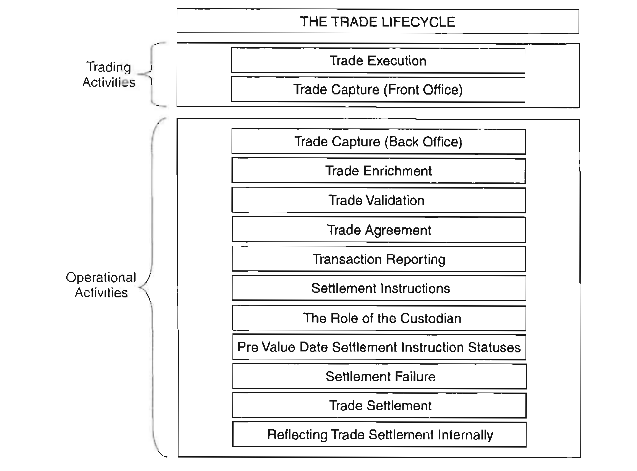Hello folks, in this blog we will learn about the trade life cycle. So before going into detail, one genuine question comes to mind is What is the Trade life cycle?
In the financial market, “trade” means to buy and/or sell securities/financial products. To explain it further, a trade is the conversion of an order placed on the exchange which results in pay-in and pay-out of funds and securities. The trade ends with the settlement of the order placed. All the steps involved in a trade, from the point of order receipt (where relevant) and trade execution through to settlement of the trade, are commonly referred to as the ‘trade lifecycle’.
The Trade Life Cycle mainly divided into two parts:
- Trading Activity
- Operational Activity
Trading Activity: Under this activity, it covers all process and procedure to capture trade from the client via front office and enrich that trade so it will able to send it for operational activity. This activity has two parts.
- Trade Execution
- Trade Capture (Front office)
Trade Execution: In this logical step we determine the trading business channel where sellers and buyers execute trades. On the basis of business channel trading markets classified into two categories.
- Quote-driven Markets: In markets where market makers publicize (quote) prices at which they are prepared to buy and sell with the intention of attracting a counterparty, the market is said to be ‘quote-driven’. Examples of quote-driven markets where quoted prices are displayed on computer screens are Nasdaq (US), SEAQ (UK) and the Eurobond market trade execution typically occurs by telephone or electronically.
- Order-driven Markets: In markets in which orders from sellers are compared and matched with buyers’ orders electronically, the market is said to be ‘order-driven.
Examples of order-driven markets are SEATS (Australia), Xetra (Germany), SETS (UK).
Trade Capture (Front office): The successful capture of a trade within a trading system should result in the trade details being sent to the back office immediately, via an interface, for operational processing. Where an STO (Securities Trading Organisation) has no trading system (nowadays a rare circumstance), the trade detail is usually recorded manually, by the trader or market maker, onto a ‘dealing slip’ this will require collection by, or delivery to, the middle office or settlement department for operational processing. Under these circumstances, the trader or market maker will need to maintain their trading position manually, keeping it updated with any new trades.
The Pictorial representation of the Trade life cycle is :

Knoldus provides Fintech solution by using the Lightbend Reactive Platform with Event Sourcing technologies to make applications fast, scalable, and fault tolerance. If you need any support then send a mail to hello@knoldus.com.
A good introduction connecting the concepts of event sourcing and how it can be useful for your business can be found in Vikas Hazrati’s article.
In the next blog, we will learn the role of operational activity in the trade life cycle.
References :
- Securities operations (A Guide to Trade and Position Management) by Michael Simmons
To explore more about the essential trading concepts and terminology, take a look at my other article “The essential trading concepts and Terminology”.

In our portfolio of the trading industry, one of a client – Singapore Stock Exchange transforms its development methodology and speed application delivery while upholding its standards for security and stability with the help of our solutions.
Technologies Used: Scala, Akka, Slick, Kafka, Kubernetes, Docker, Jenkins

